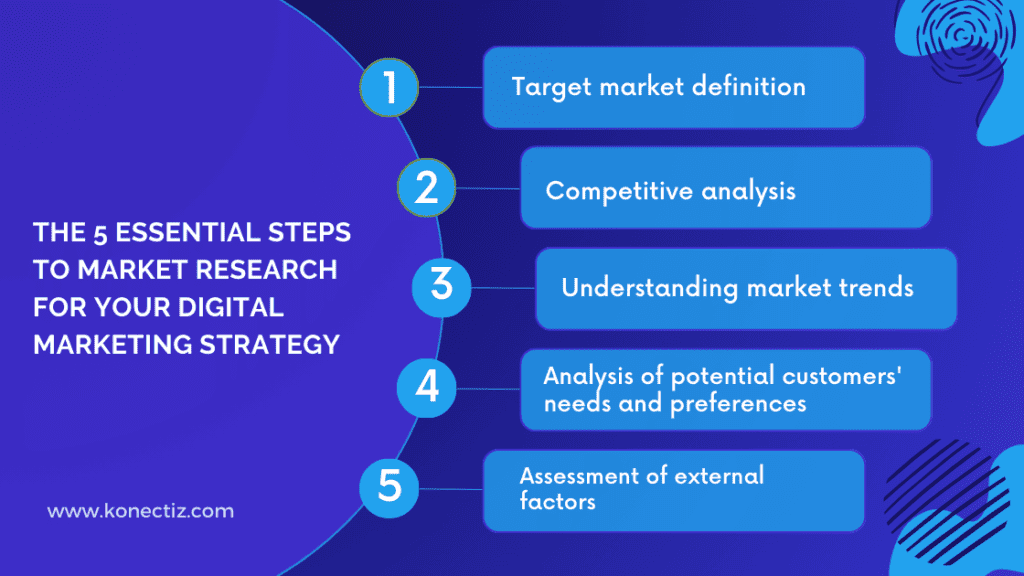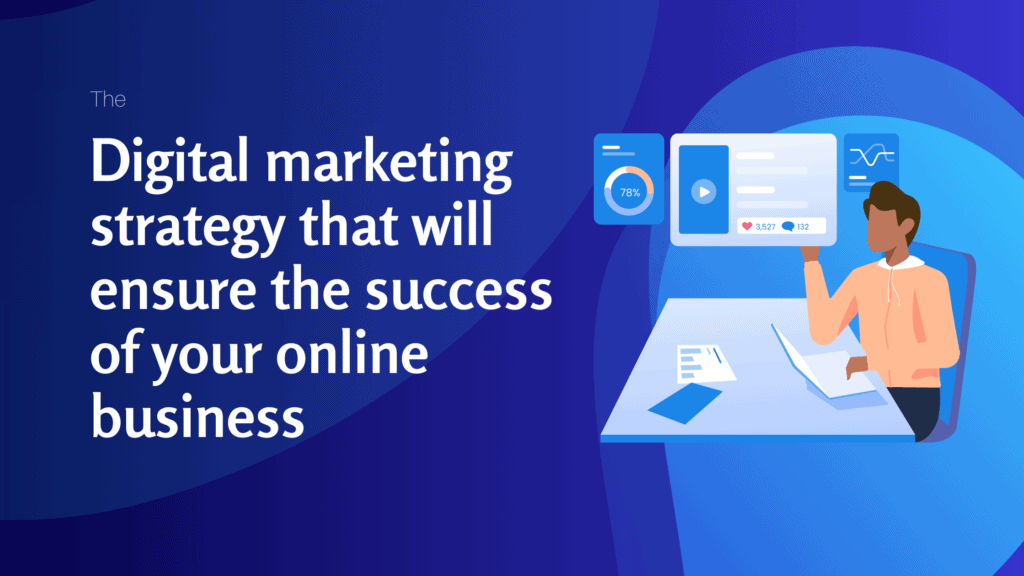Introduction
Want to ensure the success of your online business? So an effective digital marketing strategy is essential. In a world of fierce online competition, it’s crucial to have a strategy that sets you apart from your competitors and appeals to your target audience.
Our article explores a foolproof approach that will help you attract new customers, improve your online visibility and increase your sales. What is this winning strategy?
By regularly providing useful information, practical advice and relevant insights, you can establish your expertise in your field and gain the trust of your audience. Our article will guide you through the steps involved in creating a successful content marketing strategy.
The importance of a well-defined digital marketing strategy
A well-defined digital marketing strategy is essential for success in the online world. It’s what keeps you competitive and sets you apart from your competitors.
A clear digital marketing strategy enables you to define your objectives, understand your target audience and choose the most appropriate marketing channels to achieve your goals.
Without a solid strategy, it’s easy to get lost in the sea of opportunities and tactics available. A well-defined digital marketing strategy helps you stay on course, stay focused on your goals and make informed decisions about your marketing efforts. It also enables you to measure the effectiveness of your actions and make the necessary adjustments to achieve your objectives.
Key elements of a successful digital marketing strategy
A successful digital marketing strategy is based on several key elements. Here are the most important elements to consider when creating your strategy:
1. Market research
Before starting your digital marketing strategy, it’s essential to understand your market, your competitors and your potential customers. Market research will enable you to learn more about your target audience, their needs and preferences, and adapt your strategy accordingly.
2. Defining your target audience and buyer profiles
Once you’ve done your market research, you can define your target audience and create detailed buyer profiles. This will enable you to better understand the needs, motivations and behaviors of your target audience, and create content specifically tailored to them.
3. Setting SMART objectives
To measure the success of your digital marketing strategy, it’s essential to define specific, measurable, achievable, realistic and time-bound (SMART) objectives. These goals will enable you to track your progress and make sure you’re on track to achieve your business objectives.
4. Choosing the right digital marketing channels
There are many digital marketing channels available, such as social media, SEO, online advertising, e-mail marketing and so on. It’s important to choose the most appropriate channels to reach your target audience and objectives. Once you’ve defined your objectives and understood your target audience, you can choose the most effective channels to achieve your goals.
Market research for your digital marketing strategy
Market research is a crucial step in developing an effective digital marketing strategy. It involves gathering information about your target market, your competitors and your potential customers. This step will enable you to make informed decisions and adapt your strategy accordingly.
The 5 essential steps to market research for your digital marketing strategy

1. Target market definition
Identify exactly who your target audience is. This can include demographic characteristics such as age, gender, geographic location, income level, as well as psychographic aspects such as interests, values and online shopping behavior.
Use demographic data, existing market research, social media analysis and analytical tools to understand your target market.
2. Competitive analysis
Identify your main competitors in the digital marketplace. This may include companies offering products or services similar to yours.
Analyze their digital marketing strategies, including online presence (websites, social networks, blogs, etc.), search engine optimization (SEO) tactics, online advertising campaigns, special offers, etc.
Identify your competitors’ strengths and weaknesses to determine where you can position yourself competitively.
3. Understanding market trends
Identify emerging trends in your industry and in digital marketing in general. This can include the growing adoption of certain social platforms, changes in online purchasing behavior, technological developments, etc.
Use market research, industry reports, data analysis and trend monitoring tools to keep abreast of relevant developments.
4. Analysis of potential customers' needs and preferences
Use surveys, interviews and data analysis to understand the needs, desires and preferences of your potential customers.
Identify the problems they face and how your products or services can effectively solve them.
Also explore how your potential customers interact with digital channels, which platforms they use, and what types of content they prefer to consume online.
5. Assessment of external factors
Identify the external factors that could influence your digital marketing strategy, such as government regulations, economic trends, technological changes and so on. Evaluate how these factors could affect your target market, your competitors and your own marketing activities.
Define your target audience and buyer profiles
The first step in market research is to define your target audience and create buyer profiles. You need to understand who your ideal customers are, what their needs, preferences and behaviors are. This in-depth knowledge of your audience will help you create relevant content and choose the right digital marketing channels.
To define your target audience, you can use market research tools such as surveys, market studies and demographic data analysis. You can also gather information by interacting directly with your existing customers and listening to their comments and concerns.
Once you’ve defined your target audience, you can create detailed buyer profiles. These profiles will help you better understand the needs and motivations of your potential customers, enabling you to personalize your content to attract them and convert them into loyal customers.
Some tools and technologies you can use to define your target market and buyer profiles
1. SEM Rush
Sem rush keyword research and competitor analysis tool gives you information on the keywords your target market is looking for, and the websites they visit.
2. SurveyMonkey
To gather demographic data, opinions and feedback directly from your target market, you can use SurveyMonkey to create online surveys.
3. Customer Relationship Management (CRM)
CRM platforms such as Salesforce, Zoho CRM or HubSpot CRM enable you to store information about your customers and prospects, including their demographics, preferences and purchase history. This data can be used to segment your audience and personalize your marketing efforts.
Setting SMART objectives for your digital marketing strategy
Once you’ve defined your target audience, it’s time to set SMART objectives for your digital marketing strategy. SMART objectives are specific, measurable, achievable, relevant and time-bound. They help you clearly define what you want to achieve and measure your success.
When you set your goals, make sure they are aligned with your overall business objectives. For example, if you want to increase your online sales by 20% over the next six months, you can set a digital marketing objective to increase your website traffic by 30% and increase your conversion rate by 15%.
To achieve your objectives, you’ll need to define key performance indicators (KPIs) to measure your progress. For example, you can track the number of visitors to your website, the bounce rate, the conversion rate, the number of shares on social media, and so on. By monitoring these KPIs, you can adjust your strategy along the way and optimize your results.
Choosing the right digital marketing channels
Once you’ve defined your target audience and set your goals, it’s time to choose the right digital marketing channels to reach your audience. There are many digital marketing channels available, such as social media, SEO, online advertising, e-mail marketing, influencer marketing and so on.
To choose the right channels, you need to consider your target audience and their preferences. For example, if your audience is primarily active on social media, you should invest in social network advertising and content creation for social media platforms. It’s also important to regularly monitor and evaluate the performance of your digital marketing channels.
By using analytics tools, you can track your website traffic, conversion rates, e-mail open rates, ad clicks, and more. This information will enable you to adjust your strategy according to the results, and optimize your digital marketing efforts.
Market research, defining your target audience, setting SMART objectives and choosing the right digital marketing channels are key elements of a successful digital marketing strategy.
Implementing your digital marketing strategy
Now that you’ve defined your digital marketing strategy, it’s time to implement it. Here are a few tips to get you started:
1. Create an editorial calendar
An editorial calendar will help you plan and organize your content. It will enable you to remain consistent in the creation and publication of content, and help you avoid slack periods. An editorial calendar will also ensure that you cover all topics relevant to your target audience.
2. Create quality content
The key to successful content marketing is to provide quality content that meets the needs and interests of your target audience. Make sure your content is informative, useful and engaging. Use images, videos and graphics to make your content more attractive and easy to digest.
3. Promote your content
Creating quality content is not enough. You also need to actively promote your content to maximize its reach and attract your target audience. Use the appropriate marketing channels to promote your content, such as social media, SEO, online advertising and so on. Also make sure you optimize your content for search engines so that it can be easily found by your target audience.
Track and measure the success of your digital marketing efforts
Once you’ve implemented your digital marketing strategy, it’s important to regularly monitor and measure the results of your efforts. Here are some key measures you should consider:
1. Website traffic
Track the number of visitors to your website to assess the effectiveness of your digital marketing strategy. You can use web analytics tools to track your traffic and obtain detailed information on traffic sources, visitor behavior and conversions.
2. Conversion rate
Measure your website’s conversion rate to assess the effectiveness of your digital marketing efforts. The conversion rate represents the percentage of visitors who carry out a specific action, such as purchasing a product, subscribing to a newsletter, etc.
3. Social media engagement
Track engagement on your social media accounts, such as likes, comments, shares, etc. This will give you an idea of how effective your social media marketing strategy is, and how engaged your target audience is.
Conclusion
A well-developed digital marketing strategy is an indispensable element in guaranteeing a company’s success and growth in today’s online world. By implementing effective tactics such as in-depth market research, audience segmentation, the creation of relevant content and performance measurement, companies can not only attract the attention of their target audience, but also strengthen their engagement and loyalty.





